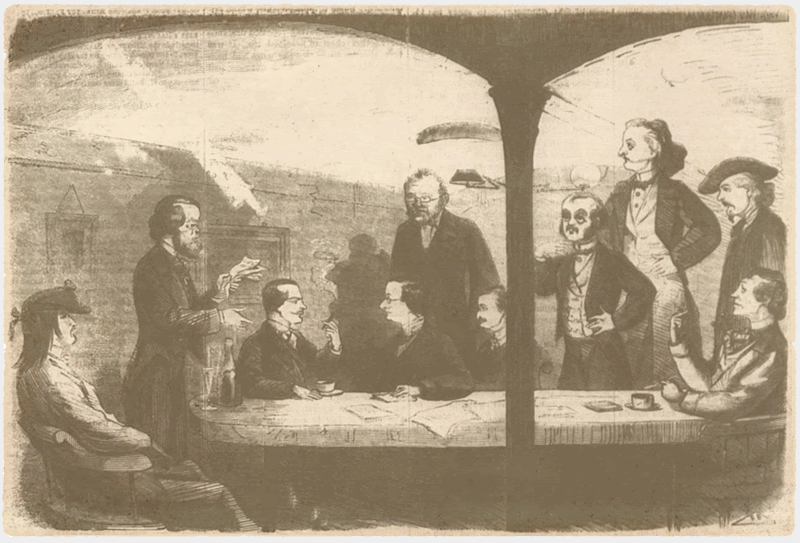
This image by Frank Bellew from the February 6, 1864 issue of Demorest's New York Illustrated News, which depicts the patrons of Pfaff's soberly discussing their work, carries the caption, "Bohemians as they are—described by one of their own number." Another image of the bohemians on the same page of the Illustrated News references the recent criticisms in The Round Table by editor Franklin Ottarson of the nightly gatherings at Pfaff's with the caption, "As they were said to be by a knight of The Round Table." The question that the Illustrated News implicitly poses in this juxtaposition of images—are literary bohemians alcoholic free-lovers or are they dedicated students of the arts?—points toward the research agenda that drives The Vault at Pfaff's, which is to provide access to the primary and secondary source documents that will allow students of American culture to determine who the Pfaff's bohemians really were and to assess their contributions to the art and literature of the antebellum United States. The Pfaffians have always held a small place in American literary history thanks to their association with Walt Whitman. But what else might these writers, artists, actors, and critics have to offer to our understanding of nineteenth-century American culture? Some of the challenges that scholars have historically faced when attempting to answer this question are that the texts about the Pfaffians have been scattered and decentralized, and that the source documents themselves are often incomplete or contradictory, leaving scholars to wonder which version of the Pfaff's story is correct.
The mission of The Vault at Pfaff's is to gather and organize both primary and secondary source documents about the bohemians of antebellum New York in ways that will help scholars to determine the impact that the Pfaffians had—either as individuals or as a group—on the literary and artistic culture of the mid-nineteenth-century United States. Presently, The Vault at Pfaff's includes brief biographical sketches of over 150 people who were connected in one way or another to the bohemian scene at Pfaff's; a searchable, annotated bibliography of over eight-thousand texts by and about the Pfaff's bohemians with links, when available, to full-text sources in a CONTENTdm viewer or on external websites; a browsable timeline of major events in the history of the antebellum bohemian scene; a map of New York City indicating where the Pfaff's bohemians lived and worked; full biographies of Ada Clare (by Gloria Rudman Goldblatt) and Anna Mary Freedman (by Shauna Martineau Robertson); and a history of Charles Pfaff's restaurant and lager beer saloon written by Stephanie M. Blalock and published in collaboration with Lehigh University Press.
The Vault at Pfaff's has been peer reviewed by NINES, a scholarly collective for digital humanities projects based out of the University of Virginia, and is co-directed by Edward Whitley and Rob Weidman with the support of the Digital Library and the Web and Mobile Services Team at Lehigh University. See the staff page for a complete list of contributors, and read more about our editorial policy and conditions of use.
Please email any questions or comments to Edward Whitley: whitley@lehigh.edu